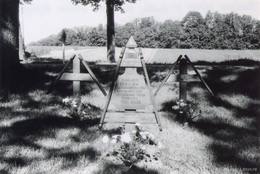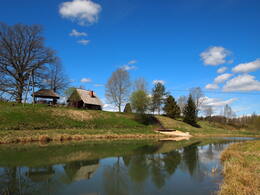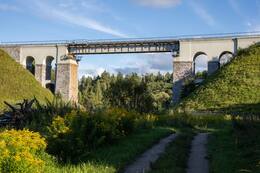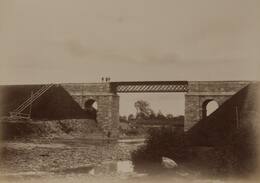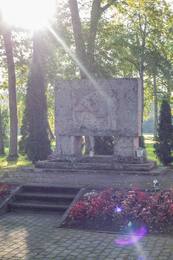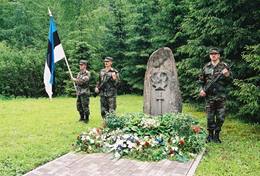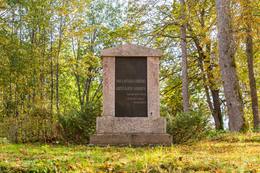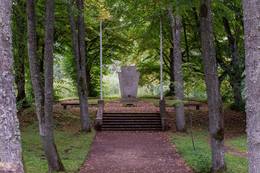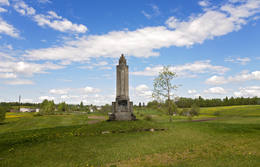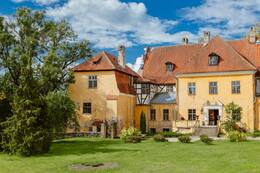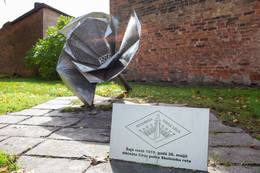Cėsių mūšio pradžia, eiga ir pabaiga
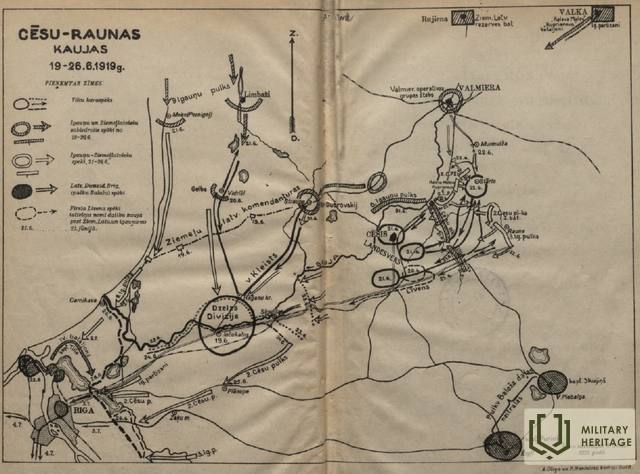
Pergalei Cėsių mūšyje buvo lemta tapti lūžiu latvių ir estų kovoje už savo šalies nepriklausomybę. Ši pergalė padarė tašką Andrievo Niedros vyriausybės ir vokiečių generolo Rüdigerio von der Goltzo planams užkariauti Baltijos šalis. Vietoj to Liepojoje savo veiklą atnaujino Laikinoji Latvijos vyriausybė, vadovaujama Kārlio Ulmanio.
Įvykiai Latvijoje prieš Cėsių mūšį
Po daugiau nei ketverius metus trukusių Antrojo pasaulinio karo kovų ir bolševikų perversmo Rusijoje, 1918 m. lapkričio 18 d., praėjus savaitei po Pirmojo pasaulinio karo paliaubų, Rygoje buvo paskelbta Latvijos valstybė. Laikinosios vyriausybės vadovu tapo Kārlis Ulmanis. Latvijos teritorija buvo nuniokota, o iš 2,5 milijono gyventojų maždaug vienas milijonas buvo pabėgėliai Rusijoje.
Latviją ir dalį Estijos okupavo vokiečiai, tačiau rytinėje sienoje stovėjo bolševikų kariuomenė, kuri 1918 m. lapkričio 13 d. anuliavus Bresto taikos sutartį ėmėsi puolimo, siekdama užkariauti buvusias atokias carinės Rusijos provincijas – Latviją ir Estiją. Gruodžio 17 d. bolševikai įžengė į Valką ir paskelbė Latvijos Tarybų Respubliką, o antra karių grupė per Daugpilį patraukė į Rygą. Vokiečių kariuomenė rimto pasipriešinimo bolševikams nepasiūlė.
Siekdama gelbėti padėtį, gruodžio 7 d. Laikinoji vyriausybė sudarė susitarimą su Vokietijos vyriausybe dėl jungtinės kariuomenės kovai su bolševikais sukūrimo. Sutartyje buvo numatyta suformuoti 18 latvių kuopų, 3 latvių baterijas ir 7 vokiečių kuopas bei 2 baterijas, iš viso 6000 karių ir 870 arklių. Vokiečiai susitarimą įvykdė tik iš dalies, daugiausia formuodami savo dalinius, bet neaprūpindami latvių ginklais. Tuo tarpu komunistų kariuomenė mažiau nei per mėnesį užėmė Latgalą ir Vidžemę ir artėjo prie Rygos.
Vokietijos vyriausybės atstovas A. Vinnigas, priešingai savo ankstesniems pažadams ir sąjungininkų norui vilkinti miesto užėmimą, paskelbė, kad vokiečių kariuomenė negins Rygos. 1919 m. sausio 4 d. bolševikai įžengė į Rygą. Dvi latvių kuopos, vadovaujamos pulkininko leitenanto Oskaro Kalpako, pasitraukė į Kuršą. Laikinoji vyriausybė persikėlė į Liepoją. Sausio pabaigoje bolševikų kariuomenė buvo sustabdyta prie Ventos, maždaug už 100 km į rytus nuo Liepojos. 1919 m. vasario 1 d. iš Vokietijos į Liepoją atvyko vokiečių generolas Rüdigeris von der Golzas. Jam buvo patikėta vadovauti Landesverui (susideda iš Baltijos vokiečių nacionalinės gvardijos ir iš savanorių Vokietijos piliečių suformuotos geležinės divizijos) ir Latvijos atskirajam batalionui kovoje su bolševikais.
Laikinosios vyriausybės pastangomis Atskirasis batalionas ilgainiui virto brigada. 1919 m. kovo 3 d. pradėtas puolimas prieš bolševikus pagerino padėtį fronte, o komunistų vadovaujama kariuomenė pamažu buvo priversta trauktis Rygos link.
Estijoje padėtis buvo daug geresnė: žmonių nuostoliai pasauliniame kare buvo daug mažesni, komunistinių idėjų įtaka mažesnė, o Suomijos parama leido po pirminių nesėkmių kontratakuoti ir 1919 metų sausį išvalyti savo šalies teritoriją nuo Raudonosios armijos.
Estijos kariai turėjo galimybę dalyvauti išlaisvinant Šiaurės Latviją nuo bolševikų. 1919 m. vasario 18 d. tarp Estijos vyriausybės ir Latvijos laikinosios vyriausybės buvo pasirašyta sutartis, suteikianti Laikinosios vyriausybės įgaliotajam kariniams reikalams kapitonui Jorģim Zemitanui ir civilinių reikalų atstovui inžinieriui Markui Gailītiui galimybę organizuoti Latvijos kariuomenę Estijoje. Tērbate (dabar Tartu) buvo suformuoti 1-asis latvių Valmiera ir 2-asis Cėsių pėstininkų pulkai. Taip buvo padėti pamatai Šiaurės Latvijos brigadai, kuri operatyviai buvo pavaldi Estijos kariuomenės 2-osios divizijos vadui.
Balandžio 16 d., tuo metu, kai buvo jaučiamos pirmosios sėkmės kovoje su bolševikais, vokiečiai Liepojoje surengė perversmą, nuvertę teisėtą Laikinąją vyriausybę, kuri turėjo prieglobsčio ieškoti garlaivyje „Saratov“. Vokiečiai sugebėjo suformuoti marionetinę vyriausybę, kuriai vadovavo klebonas ir rašytojas Andrievs Niedra.
1919 m. gegužės 22 d. vokiečių daliniai išlaisvino Rygą nuo bolševikų. Po dienos į miestą įžengė pulkininko Jāņo Baložo brigada, sustabdžiusi vokiečių vykdomas masines civilių žudynes.
Bolševikų valdžia ir Petro Stučkos kariauna pabėgo į Latgalą, nes gegužę jungtinės Estijos ir Latvijos pajėgos išlaisvino nuo bolševikų Latvijos šiaurinę pasienio sritį ir, pradėjusios nuo Ainažių, Rūjienos, Valkos ir Alūksnės, per Valmierą veržėsi Cėsių link. Birželio 1 ir 2 dienomis į Cėsius įžengė Cėsių pėstininkų pulkas, vadovaujamas kapralo Krišjānio Berkio. Atrodė, kad Šiaurės Latvijos brigada, estai, Landesveras ir Jāņo Baložo pietinė brigada turi vieną tikslą – tęsti kovą su bolševikais ir išvyti juos iš Latvijos. Tačiau Landesveras ir vokiečių geležinė divizija, užuot pajudėję iš Rygos į Rytus ir persekioję bolševikus, pasuko į šiaurę – į jungtines estų ir latvių pajėgas Vidžemėje.
Cėsių mūšis
Vokiečių generolas Rüdigeris grafas von der Golzas planavo ne tik panaikinti nepriklausomas Latvijos ir Estijos valstybes, bet ir vykti į Petrogradą atkurti Rusijos monarchijos, o vėliau atkeršyti Antantės galybėms už Vokietijos pralaimėjimą Pirmajame pasauliniame kare.
Vokiečių pajėgos nejudėjo Rezeknės-Daugpilio kryptimi, o birželio 2 d. įžengė į Ierikių stotį (12 km nuo Cėsių) ir pareikalavo laisvo maršruto į Cėsius. Šiaurės Latvijos brigada, bendraudama su Estijos kariuomenės vyriausiuoju vadu Johanu Laidoneriu, atsisakė vokiečius įsileisti į Cėsis. Birželio 3 dieną dvi Landesvero eskadrilės įžengė į Cėsį. Šiaurės Latvijos brigados štabo viršininko Voldemaro Ozolo veiksmų dėka vokiečiai buvo apsupti ir be kovos pasitraukė iš Cėsių. Birželio 5 d., tarp Cėsių ir Ierikšių, vokiečiai užpuolė estų šarvuotą traukinį. Prasidėjo Cėsių mūšis, kurį galima suskirstyti į du etapus.
Birželio 6 d., 03:00, Landesveras pradėjo greitą puolimą, remiamas sunkiosios artilerijos. 7 km pločio frontą turėjo ginti trys daugiau ar mažiau apmokytos 2-ojo Cėsių pėstininkų pulko kuopos ir per paskutines dvi dienas suformuotos trys kuopos, iš kurių viena buvo moksleivių kuopa – 16-18 metų vaikinai, palaikomi dviejų estų šarvuotų traukinių. Po 10 valandų trukusių kovų latvių kariuomenė neatlaikė trigubo vokiečių pranašumo ir pasitraukė į dešinįjį Raunos upės krantą, palikdama Cėsis. Birželio 8 dieną atvykę estų daliniai (6-asis ir 9-asis pulkai) pradėjo kontrataką, kuri nepavyko. Birželio 9 dieną Landesvero pradėtas Raunos tilto puolimas taip pat buvo nesėkmingas. Birželio 10 d. į konfliktą tarp abiejų pusių įsikišo anglo-amerikiečių sąjungininkų misija. Mūšiai nutrūko 10 dienų. Antrasis Cėsių mūšio etapas prasidėjo Landesvero vado majoro A. Fletcherio ultimatumu Estijos kariuomenės vadui J. Laidoneriui – išvesti estų kariuomenę prie Latvijos etnografinių sienų. Estijos vyriausioji vadovybė į šį ultimatumą nereagavo, nes pagal sąjungininkų reikalavimus Landesvero atstovai deryboms į Valką turėjo atvykti birželio 20 d.
Mūšiai dešiniajame Gaujos krante prasidėjo birželio 19 d. vidurdienį, kai prie Vidrižių Geležinės divizijos priešakiniai daliniai susirėmė su Estijos 9-ojo pulko skautais. Birželio 20 d., 18.30 val., Estijos 3-iosios divizijos vadas Ernestas Pedersas davė įsakymą pradėti karo veiksmus prieš Landesverą.
Tačiau naktį iš birželio 20-osios į 21-ąją divizijos štabas gavo pranešimą, kad pagrindinės vokiečių pajėgos pradėjo puolimą kairiajame Gaujos krante, kryptimi nuo Cėsių link Jaunraunės ir Veselavos, o prie Raunos tilto, Lodės stoties ir Liepos dvaro vyksta žūtbūtinės kovos.
Birželio 21-osios rytą landesverui pavyko pralaužti frontą tarp 2-ojo Cėsių pulko ir 3-iojo Estijos pulko. Jaunraunos apylinkėse 2-ojo Cėsių pulko kairysis sparnas turėjo trauktis. Mūšio eigą gerokai pakeitė kapitono Unto vadovaujamas Kuperjanovo partizanų batalionas. Išlipęs iš traukinio, jis pradėjo kontrataką nuo Lodės stoties Liepos dvaro link.
J. Kuprejanovo batalionas, palaikomas šarvuočio ir latvių artilerijos baterijų, visą dieną atlaikė mūšį su vokiečiais, o vakare užėmė Liepos dvarą. Nepaisant šių Estijos partizanų kovų, Landesveras sugebėjo į plyšį (apie 6 km) įvesti pakankamą karių skaičių, kuris buvo padalintas į tris dalis. Vienas, Jaunraunės kryptimi, nuvažiavo į Lodės stotį, kur susirėmė su minėtu J. Kuperjanovo batalionu. Kita dalis patraukė toliau link Skangalių dvaro, bet vokiečių skautai nukeliavo net iki Mūrmuižos (10 km nuo Valmieros); taip kelia grėsmę šarvuotų traukinių judėjimui iš Valkos į Cėsius. Trečioji dalis, aplenkdama dešinįjį Estijos 3-iojo pulko sparną, patraukė link Raunos. Estai šią vokiečių grupę sustabdė Raunos aukštumose.
Dramatiška situacija susiklostė Skangalių dvaro teritorijoje, kur buvo daug Landesvero pajėgų. Situaciją išgelbėjo ešelonas su Kalevos bataliono ir 1-ojo pulko 2-ojo bataliono naikintuvais, atvykęs birželio 22 d. 3 val. ryto. 3 km į šiaurę nuo Lodės stoties kariai išlipo ir šarvuotame traukinyje Nr. 2 oro desantininkai patraukė link Skangalių dvaro. 6.30 val. šios pajėgos įsiveržė į dvarą, tačiau po kurio laiko Landesvere atkovojo Skangalių dvarą. Vokiečių nuostoliai – 60 žuvusiųjų. Žutų, sužeistų ir traumuotų kalevių karių skaičius siekė 62. Landesveras ėmė netvarkingai trauktis link Cėsių. Už kelių kilometrų, netoli Starto, vokiečiai neteko dar 31 žuvusio. Kiti Estijos ir Latvijos daliniai taip pat įsitraukė į aktyvius karo veiksmus. J. Kuperjanovo bataliono partizanai tęsė puolimą Jaunraunos kryptimi, nutraukdami 3000 vokiečių traukimosi kelią iš Skangalių. Jis baigėsi lemiamą istorinių kovų dieną. Priešas buvo nugalėtas centre.
Vėlų birželio 22 d. vakarą Estijos Respublikos įgaliotasis atstovas N. Reksas paskelbė nurodymą:
"Neturime duoti priešui galimybės organizuotis ir persigrupuoti po smūgio, gauto per dvi kovų dienas. Turime toliau sutriuškinti priešą ir užimti Cėsis."
Taigi birželio 23-ioji buvo pažymėta jungtinių Estijos ir Latvijos pajėgų puolimu abiejuose Gaujos krantuose.
7:30 Cėsis buvo užimtas, o 8:00 Estijos 6-asis pulkas dešiniajame Gaujos krante taip pat pradėjo kontrataką. Tos pačios dienos vakare priešas buvo atstumtas 50 km nuo Cėsių iki Inčukalno. Birželio 26 d. iš šių pozicijų į Rygos pakraščius buvo išvarytos ir vokiečių pajėgos. Liepos 3 dieną buvo pasirašytos sąjungininkų priverstos Strazdumuižos paliaubos, kurios išgelbėjo vokiečius nuo visiškos nelaimės ir suteikė galimybę spalio mėnesį po Avalovo-Bermonto vėliava atnaujinti kovą su naująja Latvijos valstybe. Šiandien galime drąsiai teigti, kad Cėsių mūšyje latviai kovojo už Estijos, estai – už Latvijos nepriklausomybę.
Pirmąjį pasaulinį karą laimėjusių šalių – JAV, Anglijos, Prancūzijos – vaidmuo kuriant laisvas Latvijos ir Estijos valstybes
Sąjungininkų deklaruota tautų apsisprendimo teisė buvo skirta sunaikinti priešų imperijas – Vokietijos, Austrijos-Vengrijos, Turkijos imperijas ir sukelti sunkumų vokiečių okupuotoje Rytų Europos teritorijoje, bet nebuvo skirta sutriuškinti savo ir Rusijos imperiją. Taip pat nebuvo vienybės tarp sąjungininkų – Anglijos, Prancūzijos, JAV – dėl Latvijos ir Estijos statuso. Tik trumpą laiką – iki 1918 m. gruodžio 31 d. – britai palaikė Rusijos pasienio kraštų nepriklausomybę.
Amerikiečiai ir prancūzai buvo suinteresuoti atkurti Rusijos imperiją, kad būtų išsaugotas deponuotas kapitalas. Dėl sąjungininkų spaudimo Didžiosios Britanijos vyriausybė nusprendė nutraukti aktyvią paramą Rusijos pasienio valstybių laikinosioms vyriausybėms, naudodama jas tik antisovietinėse ir antivokiškose kombinacijose. Tai galime pagrįsti 1919 m. gegužės 26 d. Antantės sprendimu dėl Baltijos tautų autonomijos pripažinimo Rusijos imperijoje.
Tik kai vokiečiai Latvijoje tapo nevaldomi sąjungininkams (gegužės 23 ir 24 d. Liepojoje vokiečiai suėmė Antantės karininkus ir instruktorius), po birželio 5–7 d. Liepojos diskusijų sąjungininkai nusprendė panaudoti Latvijos ir Estijos nacionalines ginkluotąsias pajėgas vokiečiams sulaikyti. Tai buvo būtina ir dėl to, kad vokiečių puolimas prieš jungtines pajėgas nutraukė bolševikų persekiojimą, o tai neatitiko Antantės interesų. Birželio 22 dieną Vokietijos nacionalinė taryba nusprendė pasirašyti taikos sutartį su Antante. Taigi estai ir latviai, kovodami dėl savo interesų, padarė vertingą paslaugą Antantei, užkirtę kelią vokiečių bandymui užgrobti absoliučią valdžią Baltijos šalyse. Tik birželio 25 dieną Antantės aukščiausioji vadovybė nusprendė, kad vokiečiai neberemti. Birželio 28 dieną vokiečiai pasirašė žeminančią Versalio sutartį.
Latvija 1919 – įvairios vyriausybės Nepriklausomybės karo metais
Latvijos teritorijoje buvo įsikūrusi Peterio Stučkos vadovaujama ir Raudonosios armijos remiama Latvijos Socialistinės Tarybų Respublikos vyriausybė. P. Stučkos vyriausybės tikslas buvo išlaisvinti naujai įkurtos valstybės teritoriją ir joje įtvirtinti sovietų valdžią.
Kuržemėje veikė Andrievo Niedros vadovaujama provokiška vyriausybė, remiama vokiečių Landesvero ir Geležinės divizijos. Šios vyriausybės tikslas buvo išvaryti iš Latvijos bolševikus, užkariauti kuo daugiau teritorijų ir išlaikyti vokiečių valdžią Pabaltijyje.
Trečioji – Laikinoji Latvijos vyriausybė, vadovaujama Kārlio Ulmanio, po vokiečių surengto perversmo balandžio 16 d. prieglobstį rado garlaivyje „Saratov“. Kelio šiaurinėje Latvijos vyriausybei liko Janio Baložo vadovaujama Pietų Latvijos brigada Kuršijoje ir Šiaurės Latvijos brigada, kuriai vadovavo pulkininkas Jorģis Zemitāns. Politiškai abi brigados buvo lojalios Latvijos laikinajai vyriausybei, tačiau kariniu požiūriu Pietų Latvijos brigada buvo pavaldi generolui von der Golzui, kuris taip pat vadovavo Landesverui ir Geležinei divizijai, o Šiaurės Latvijos brigada – Estijos kariuomenės vyriausiajam vadui generolui Johanui Laidoneriui.
Tālis Pumpuriņš, Cėsių istorijos ir meno muziejus
Edgaro Andersono istorinės medžiagos
Susijusi laiko juosta
Susijusios temos
Susijusios vietos
Victory monument in Cēsis
The Victory Monument to Latvians and Estonians killed in the Battles of Cēsis is located in the city of Cēsis, on Vienības Square. In honour of the participants of the 1919 Battles of Cēsis, on 22 June 1924, the first stone was laid for the Victory Monument as sketched by architect Pauls Kundziņš, using funds donated by the people. During the Soviet occupation regime, on the night of 25 March 1951, the monument was blown up and taken down completely. A monument to Lenin, created by sculptor Kārlis Jansons, stood on the former Victory (Unity) Square from 1959 to 1990. In 1997, Māris Niklass, chairperson of the Cēsis District Council, managed to involve Estonian state institutions in the restoration of the monument. The material needed for the construction of the monument, Saaremaa dolomite, was received from Estonia as a gift. On 22 June 1998, during the celebrations of the 79th anniversary of the Battles of Cēsis, the first stone of the monument to be restored was laid on Vienības Square. A ceremony to unveil the restored Victory Monument took place in Cēsis on 15 November 1998 (author: architect Imants Timermanis). Information about the Victory Monument is available in the ‘Cēsis and the Latvian War of Independence’ exhibit of the Cēsis History and Art Museum, in the New Castle.
Monument commemorating the Cēsis battles
The monument to the Estonian and Latvian soldiers who died in the Battles of Cēsis is located in Priekuļi municipality, Liepā, about 1 kilometre south of the Lode Railway Station, on the side of Rūpnīcas street. The first stone of the monument was laid on 22 September 1929, and the monument was unveiled on 11 August 1935. Based on a sketch by Sculptor Augusts Julla who lived in Jullas, Liepa parish, and made of limestone from the village of Allaži, the monument is a high-relief depiction of a peasant soldier leaning on a plough with one hand and a raised sword in the other. The death mask of the sculptor’s father Jānis Julla was used to create the face of the sculpture. According to Aivars Vilnis, a researcher of the history of Liepa parish, a bird’s eye view of the monument reveals that the base of and the path and stairs leading to the monument form the shape of an arrow facing Liepa Manor (Lindenhoff) in the direction of German positions during the Battles of Cēsis. There is doubt, of course, as to whether this was truly the author’s intention at the time; however, it certainly enriches our interpretation of the monument today. Next to the monument are the only natural sandstone arches in Latvia known as ‘Lielā Ellīte’ (‘Liepas Ellīte’ or the Devil’s Kiln).
Cēsis history and art museum in the New Castle of Cēsis
The Cēsis History and Art Museum is located in the very centre of the Old Town of Cēsis, in the New Castle. The museum holds a permanent exhibit of history and interiors named ‘Cēsis, a Symbol of Latvian History’, with two thematic sections: the exhibit ‘Red-White-Red Flag in the History of Cēsis and Latvia’ explains the history of the Latvian national flag from the 13th to 20th centuries, the approved national symbol, the flags of Latvian rifle battalions and the traditions of using national colours during the Latvian War of Independence. The exhibit ‘Cēsis and the Latvian War of Independence’ focuses on the founding of the Cēsis Company in December 1918, the joint battle efforts of Estonians and Latvians in the 1919 Battles of Cēsis, the time when, during the Bermondt Affair, Cēsis served as the temporary capital of Latvia for a short time, as well as the history of the Cēsis Victory Monument. In an escape room named ‘Legends of the Battles of Cēsis’, the participants have one hour to find their way out by solving puzzles, making connections and finding hidden objects. The Cēsis Company, one of the first units of the Latvian Armed Forces, was established on 8 December 1918 in Cēsis Castle by Senior Lieutenant Artūrs Jansons. The museum’s exhibit features a memorial plaque dedicated to the Cēsis Company, unveiled on 8 December 1933 at the Cēsis New Castle, which, at the time, served as the headquarters of the 8th Daugavpils Infantry Regiment and the garrison officers’ club.
Monument for students of the Cēsis Regiment
The monument to the soldiers of the Cēsis Regiment Students’ Company who died in the Battles of Cēsis is located in the city of Cēsis, near the intersection of Palasta and Bērzaines streets. The construction of the monument was proposed by the Soldiers’ Association of the Cēsis Regiment Students’ Company. The monument was unveiled on 26 May 1938. The monument is based on the idea sketched by artist Jānis Rozenbergs, a former soldier of the company. Placed on a metre-high limestone pedestal, the 1.8-metre copper sculpture of a soldier dressed in a school student’s uniform was created by sculptor Rūdolfs Āboltiņš and coppersmith Jānis Zibens. An owl, a symbol of wisdom and knowledge, lies at the soldier’s feet, squatting on and protecting the books of a student who went to war. The sculpture was demolished during the Soviet re-occupation in 1952. A monument named the Komsomol Flag Bearer by sculptor Kārlis Jansons was erected near its former location in 1957. Placed near its historic site, the restored monument was unveiled on 11 November 1992. At the same time, in 1992, a monument to the Komsomol, which had been erected by the occupation regime, was taken down.
Monument to the students' ornaments at the battlefield
On the side of the Cēsis-Āraiši highway, near the former Livu parish.
A monument dedicated to the ornament of volunteers of the Cēsis Regiment, who took part in the battles of Cēsis in 1919, can be seen.
The monument was unveiled on May 29, 1930 near the former Livu parish.
The project of the monument was developed by the former volunteer of the school ornament K.Dzirkalis, the installation works were performed by A.Sproģis firm in Cēsis.
Bronze details according to the author's drawing were created by M.Pluka, they were cast at V.Minūta's factory in Riga. After World War II, the monument was destroyed.
Restored on June 6, 1989, the authors of the restored monument are sculptors A. Jansons and M. Balttiņa, architect I. Timermanis.
Later, the bronze sword and plate were removed for safety reasons and replaced with wooden parts.
Memorial stone in the battles of Cēsis near the fallen Latvian and Estonian soldiers
Located in Priekuli Parish, on the side of the Cēsis-Valmiera highway near the bridge over Rauna.
A memorial stone with a granite memorial to the soldiers killed in the battles of Cēsis, made by stonemason Voldemārs Koltovs, can be seen.
Discovered in 2004, when the 85th anniversary of the Battle of Cēsis was celebrated.
A memorial stone to 110 Estonian and 44 Latvian soldiers killed in battles on the banks of the Rauna and Gauja banks.
The 6th Regiment of the 3rd Estonian Division (Commander K.Tallo), the 3rd Regiment (Commander J. Krūss) and the 2nd Cēsis Regiment of the Northern Latvia Brigade (Commander K.Berķis) fought heroically in the battles near Rauna and Gauja.
The first monument to the Battle of Cēsis and the fallen Estonian soldiers
Located next to the Veselava cemetery chapel.
The first monument to the Battle of Cēsis and the fallen Estonian soldiers was unveiled on August 5, 1923.
The first President of the Republic of Latvia Jānis Čakste and the Estonian Ambassador to Latvia Jūlijs Saljema took part in its opening.
16 Estonian soldiers were buried in the cemetery, who fell in June 1919 in the battles of Cēsis with the Baltic Landesver and the Iron Division. Four of them were later reburied in their homeland. The monument was built on donations collected by locals. It was made by craftsman Dāvis Gruzde according to the design of Kārlis Bierņš, the owner of Ķikuri houses.
Cesis Brothers Cemetery
Located in Cēsis Lejas Cemetery, Lenču Street 15, Cēsis.
One of the most important memorial sites of the First World War and the War of Independence in Cēsis is the Brothers' Cemetery in the Lower Cemetery.
The cemetery is the monument of the Brethren's Cemetery, built in 1927 by the artist and thinker of Cēsis Augustus Julla (1872-1958), dedicated to the soldiers buried in the Brothers' Cemetery from 1915 to 1920.
About 200 soldiers are buried in the Brothers Cemetery of Cēsis Lower Cemetery. Among them, an unknown number of Latvian riflemen and Russian soldiers killed in the First World War, as well as soldiers of German (10), Polish and other nationalities. During the Latvian Liberation War, 22 fallen soldiers of the 5th (2nd) Cēsis Infantry Regiment, as well as 11 freedom fighters who fell in other Latvian army units, were buried in these cemeteries. 2 Estonians, 15 victims of Bolsheviks and also Latvian Red Riflemen are buried in the Brothers' Cemetery.
Monument for students of the Viljandi Regiment
The monument to the soldiers of the Viljandi Students’ Company who fell near Stalbe is located by the intersection of the Riga-Limbaži road, after making a turn onto the Stalbe-Stūrīši road, which leads to the Pārgauja Municipal Council (to the right). Latvian and Estonian inscriptions on the granite memorial read: ‘On 19-21 June 1919, during the Battles of Stalbe, the 6th Regiment Viljandi Students’ Company repelled the attack of the Germans’. The monument was unveiled on 19 June 2009. Based on the idea conceived by Mareks Niklass, the monument was created by stonemason Voldemārs Koltovs. The 6th Estonian Regiment fought the Baltic Landeswehr and the Iron Division during the Battles of Cēsis near Stalbe. The Germans tried to break the front line in the area of the Stalbe Manor but were forced to retreat after two days of failed attempts. Every year, Lāčplēsis Day celebrations in Stalbe begin with a torchlight procession to the monument devoted to the soldiers of the Viljandi Students’ Company.
Monument in memory of the fallen soldiers of the Latvian Liberation War
The monument is located next to Limbaži Sv. St. John's Lutheran Church, Lībiešu Street 2. There is a memorial to the fallen soldiers of Limbaži and the surrounding area and to Lieutenant General Vilis Gelbe (1890-1919), who fell in the battle against the Germans on June 19, 1919 in Vidriži.
The monument of Lieutenant General Viļis Gelbe can be seen in the Limbaži cemetery in Jūras Street.
Monument to the sea lieutenant, L.k.o.k. Vilis Gelb (1890-1919)
Located in Limbažu Jūras iela cemetery, Jūras iela 56, Limbaži
The monument opened on September 10, 1922 by the then President of Latvia Jānis Čakste, on which the dedication of the poet Viļas Plūdonis to Vilis Gelb is read:
"Compatriots who pass by me, light up in the love of the fatherland,
for the beloved fatherland, I pledge my life."
Vilis Gelbe (1890-1919) was born in Kurzeme, Zemīte parish, but he is also closely related to the Limbaži side, because at the beginning of the Latvian War of Independence, he returned to Latvia from St. Petersburg and joined the North Latvian Brigade.
In May 1919, V. Gelbi commanded Limbaži, he became the military commandant of the area and was able to inspire local men and also very young guys to join the army.
V. Gelbe's activity at that time in Limbaži and its surroundings was very important, his duties included not only maintaining order in the city and its surroundings, but also mobilization, providing food for soldiers and horses, and solving many other issues that cannot be included in orders and instructions. The Commandant's team organized by him acted as a coordinated mechanism to provide the North Latvian Brigade with the most effective assistance possible. The commander's team went to the aid of the regular army in special cases, and he set an example for the new soldiers. V. Gelbe was the first Latvian army officer who proposed to award his subordinates with the III class of the Order of Imanta. There was no order yet. Imanta's name appeared in the open only on March 20, 1920, when the minister of defense, Karls Ullman, was presented with an outline of the establishment of the military order. However, the name of Lāčplėš was chosen for the order.
Vilis Gelbe died during the battles of Cēsis - on June 19, 1919, during a reconnaissance. Later, Gelb was awarded the Láčplēš War Order, however, historians believe that his contribution has not been properly appreciated until now. This is mainly explained by Gelbe's membership in the Northern Latvian Brigade.
The so-called Southern Latvian brigade, which was initially commanded by Oskars Kaplak, later Jānis Balož, competed with the Northern Latvian brigade, which was commanded by Jorģs Zemitāns.
In Vidriži, a memorial sign at the place where LKOK Vilis Gelbe and two soldiers of his team fell
In Vidriži, at the turn to Lēdurga, during the Freedom Struggle on June 19, 1919, Marine First Lieutenant Vilis Gelbe and two soldiers fell in battle.
Vilis Gelbe is buried in the Limbaži cemetery. Vilis Gelbe was awarded the III class of the Lāčplēš War Order (No. 895) for his heroic deed at Vidrižu manor.
Currently, three commemorative crosses installed in 1989 can be seen at the battle site.
On June 22, 1934, a bronze commemorative plaque made by the artist Stefan Berc was unveiled near the maple growing in the manor park. Already at the beginning of the communist occupation, in the fall of 1940, the memorial plaque disappeared. The maple to which it was nailed also died. At the beginning of the Revival, on June 19, 1989, on the 70th anniversary of the death of Gelbe and two soldiers of his team - corporal Krustiņš and soldier Krūza - at the crossroads where a memorial plaque used to be, on the initiative of the Environmental Protection Club and Latvian People's Front branches of Limbažu county, installed three wooden crosses made in folk style by Jānis Eglīš. By the decision of the executive committee of Limbažu district in April 1991, this memorial place was included in the list of historical monuments of local significance.
Memorial at Skangaļi Manor
The memorial to the victory of the combined Latvian and Estonian troops in the battle for the Skangaļi Manor is located about 20 kilometres from Cēsis. Devoted to the participants of the Battles of Cēsis and the fighters of the Estonian Kalevlaste Maleva Battalion, the memorial stone was unveiled on 22 June 2019. The victory of the combined Latvian and Estonian troops in the battle for the Skangaļi Manor, which took place here, was a turning point in the Battles of Cēsis, as a result of which the troops of Niedra’s government initiated a general retreat. The government of Andrievs Niedra was a provisional pro-German government of Latvia, which existed from 10 May to 26 June 1919. The attack on the Landeswehr unit began in the early morning of 22 June 1919 when the 3rd Kalev company used an armoured train to break into the Skangaļi Manor where they seized 2 cannons, however, the enemy still went on a counterattack. The troops repeated the attack slightly later, in the middle of the day, and the Landeswehr unit was forced out of the Skangaļi Manor following fierce close combat. The trophies from the battle include machine guns, large quantities of ammunition and other combat equipment. Two hours later, the Estonians captured an important road junction at the Starti pub. 58 Kalev soldiers were injured or lost their lives in the battle to capture the Skangaļi Manor. Estonia provided significant support in establishing the memorial site.
poilsio vieta „Miško mūšis“ (Meža kaujas) – Cėsių mūšių svarbiausios veiksmo vietos prie Amatos tilto
Named Forest Battles, the rest area is situated in the main location of the Battles of Cēsis near the Amata bridge. Visitors can listen to stories about the Battles of Cēsis and can take part in various activities, including hikes and trips around the most important venues of the Battles of Cēsis, and team battles. At the end, the visitors can enjoy an invigorating wartime soup. The railway bridge over Amata played a very important role throughout the War of Independence, as the first clashes of the Estonian Army with the Landeswehr took place here. On 5 June 1919, the first battle of the Estonian Army’s armoured trains with the Baltic Landeswehr units took place by the railway bridge over Amata. The Landeswehr, knowing that an armoured train was approaching, planted mines on the railway bridge and secured positions at the homestead Amatas on the riverbank in preparation for a possible battle. The bridge over Amata marked the border between Estonian forces and the Germans. On the night of 23 June 1919, during the Battles of Cēsis, the Landeswehr left Cēsis and retreated to the Amata river line. When retreating, the Germans burned down the Cēsis Latvian Society House and blew up the bridge over Amata.
A unique opportunity is offered to watch the events of June 5, 1919 through virtual reality glasses.
The railway bridge over the river Rauna
The railway bridge over the River Rauna is located near the P20 highway, in Priekuļi parish. It can be viewed from the right side of the Cēsis-Valmiera highway. The railway bridge is not intended for pedestrians and is watched over by security guards. Built in 1889, the masonry bridge on the Riga-Valka railway line is the highest railway structure of its kind in the Baltics. It is 24 metres high and 78.9 metres long. Trains, especially heavy freight trains, must maintain a speed of 80 km/h. Higher speeds are not allowed on the bridge. However, at lower speeds, the train is unable to deal with the slight incline on both sides of the bridge and may start to slide backwards. In June 1919, during the Estonian and Latvian Wars of Independence, reinforcements to the Estonian Army, which also included the Northern Latvian Brigade, were sent by rail across the bridge from Valka, which was at the back of the front. When the 2nd Cēsis Infantry Regiment was forced to retreat from Cēsis, its units strengthened their positions on the banks of the River Rauna. The railway bridge became part of the fortification and ensured the movement of Estonian armoured trains during the battles. During World War II, on 4 July 1941, the bridge was blown up by the fleeing Red Army when the Soviet occupation of Latvia was replaced by the German occupation. German Army sappers restored the bridge within a week. After World War II, during the Soviet occupation, the bridge over Rauna was of military strategic importance and was heavily guarded.
Railway bridge over Amata
Located in Drabešu parish, Cēsis region, near the recreation place "Meža kaujas".
There is a railway bridge over Amata.
The railway bridge over Amata played a very important role throughout the War of Independence, because on June 5, 1919, the first battle of the Estonian army's armed trains with the Baltic Landesver units took place here. Landeswehr, knowing that an armed train was approaching, nominated a railway bridge and took a position at the Amatas home on the river bank, ready for possible warfare. The bridge over Amata was the border between Estonian forces and the Germans.
Historical evidence of the events at the Amata Bridge has not been preserved. As Latvians did not take part in these events, there are no narratives of their memories, there are memories from Estonian soldiers and other sources. It can be said that this was an Estonian-American joint battle against the Landeswehr, because there was an American officer on the Estonian armored train, who later fought in World War II as well. In general, many future World War II officers and commanders took part in the battles of Cēsis, especially on the German side.
The Estonian armed train arrived in Cēsis on June 2, 1919, a day later went to Ieriķi, where talks took place with the landlord, which was unsuccessful, and on June 5, when the armed train approached the Amata bridge again, a collision with the Germans began. A day later, the armed train also took part in the battles near Cēsis, where it helped the soldiers of the Pupils' Company who were threatened with siege. Although the Germans tried to dismantle the rails to cut off the train's retreat, it managed to retreat across the Rauna bridge.
On the night of June 23, 1919, during the battles of Cēsis, the landesver left Cēsis and retreated to the Amata river line. When they retreated, the Germans burned down the house of the Cēsis Latvian Society and blew up a bridge over Amata.
Monument to the liberators of Northern Latvia
Located in the center of Placa by the Inčukalns - Valka highway (A3). Next to the bus stop and Straupe People's House.
The monument made by Teodors Zaļkalns to the liberators of Northern Latvia in 1919 at the Battle of Cēsis can be seen.
There are two limestone supports on the three-step base, on which the limestone block rests. In front of it, the lower part depicts a horse harnessed to a plow and a plow holding reins in his right hand and a sword in his left. A text engraved on the back of the monument, closed by lines by the poet Eduards Virza:
FOR THE RELEASES OF NORTHERN LATVIA
WHILE THE CEREALS ARE SEED IN THESE FIELDS
YOU WILL BE GLORIFIED AND HONORED
The monument was unveiled on November 8, 1931. President Alberts Kviesis took part in the opening.
Monument in memory of the soldiers killed in the War of Independence
Located in Raiskuma Cemetery near the chapel.
The monument to the soldiers killed in the battles of Cēsis was unveiled on September 7, 1930. The monument was made in the local red-gray granite by Cēsis stonemason A. Sproģis. In 2001 the monument was restored.
At the commemoration of the 93rd anniversary of the Battle of Cēsis, Lieutenant-Colonel Ēvalds Krieviņš, who was retired in the Freedom Fights, revealed to the audience that not only the fate of Vidzeme, but also Latvia and partly Europe was decided in Raiskums parish near Auciemmuiža in 1919.
"Here the Estonian regiment heroically wounded the Iron Division and struck the first plane during the War of Independence," says Ēvalds Krieviņš.
Memorial to Estonian soldiers killed in the Latvian War of Independence
Located on the bank of the river Salaca, near the cemetery, Upes Street 3a.
The cemetery was consecrated for the first time in June 1927. In the spring of 1936, at the suggestion of the local guard organization, a cemetery hill was created, where two unknown Estonian soldiers were reburied. The cemetery was consecrated on August 16, 1936. During both the German and Soviet occupation, the cemetery stood abandoned, surrounded by linden trees.
The Estonian Ministry of Defense, in co-operation with the Latvian Ministry of Defense and the Brothers' Cemetery Committee, accepted the Latvian side's proposal to concentrate all individual burials of fallen Estonian soldiers in Mazsalaca, where an ensemble of 2 Estonian soldiers had already been formed after the Freedom Fights.
On June 18, 2013, the monument to the Brothers' Cemetery of Estonian soldiers killed in the Latvian War of Liberation was unveiled on this cemetery hill. The monument was made of Saaremaa dolomite by the Estonian company Dolokivi OÜ after SIA Arhitektu birojs Vecumnieks & Bērziņi. The Minister of Defense of Estonia Urmas Reinsalu and the Minister of Defense of Latvia Artis Pabriks participated in the opening.
On November 11, 2015, 10 new reburials of unknown soldiers who died in the War of Independence were consecrated.
A monument to the memory of the members of the Drustu parish who fell in the First World War and in the battles for the Liberation of Latvia
It is located near the Drustu Lutheran Church.
The monument was opened on June 19, 1932.
On June 14, 1931, the foundation stone of the monument was laid, on which the text "Hundreds of years will come and go, heroes will sacrifice themselves for fatherhood". A galvanized tin capsule with a memorial letter signed by the then Chief of Army Staff General Aleksanders Kalējs, parents of the fallen soldiers and other honored guests of the ceremony is embedded under it.
During the communist occupation, the text under the tab was cemented, but the bronze tab was hidden by the parishioners. When the Revival began, local activists of the Latvian People's Front cleaned the inscription and placed the preserved tab in its place.
41 members of the Drustu congregation who died in the First World War and the Latvian War of Independence have been identified.
Placed in the niches of the church wall are commemorative plaques for the victims of the communist terror - with 58 names of Drustenians and Gatartians carved into oak - the names of people whose graves are unknown.
Lielstraupe Castle
The Lielstraupe Castle is located in the centre of the town of Straupe. The castle is open to visitors and offers a journey through the centuries along with an orienteering exercise in the labyrinths of the castle. During the Battles of Cēsis, the Lielstraupe Castle housed the command post of Paul Ludwig Ewald von Kleist’s Battle Group of the Iron Division (German: Eiserne Division). During the battles, the castle was visited by Major Josef Bischoff, Captain Heinz Guderian and others. The castle was used for the coordination of an attack in the direction of Stalbe on 21-22 June. The Iron Division was a military force of German mercenaries during the Latvian War of Independence, which was formed from soldiers of the 8th Army of the demobilised German Empire and volunteer mercenaries. It was the best-known part of the German Free Corps and among the best trained and most combat-ready military forces in the Baltics in 1919. During the Soviet period, from 1949 to 1959, the administration of the Lielstraupe Machine-tractor Station operated out of Manor Castle. During this time, the castle was also equipped with training rooms and dormitories for tractor drivers, while the former stable of the manor housed workshops. From 1963 to 2018, the castle was managed by medical institutions, and it was said of the Straupe Narcological Hospital in Latvia that it ‘even treats the walls’.
Monument to the first fallen soldier of the Schoolmen's Company, Edgars Krieviņas
Located in the Central Cemetery of Valmiera, near the chapel (Miera Street 1/3, Valmiera)
A soldier of the 8th (Skolnieki) company of the Cēsi regiment, LKOK Edgars Krieviņš (1899-1919), died on June 7 from injuries sustained in the battles of Cēsi on June 6, 1919, when he covered the retreat of the rest of the units when the Landsweer attacked.
Memorial sign at the founding site of the Cēsis Regiment School Company
Located at Leona Paegles Street 1, next to the red brick facade.
The author of the memorial is the artist Solveiga Vasiljeva, and the idea is based on a flower bud motif. According to the artist, it symbolizes the newly formed personalities - students who have to make an important, responsible and harsh decision in their still short life.
In the form of a memorial, the outer petals of the flower bud are made of geometric, sharp corners, in contrast to the gentle, rounded inside of the bud. The height of the memorial is up to 1.5 m. The memorial was unveiled on May 26, 2011 in Valmiera, the place where the orchestra of the Cēsis Regiment was formed in 1919.
The contours of Latvia are made of artificial cobblestones, on which a plate with the flag and text of the Cēsis Regiment Students' Association is placed:
"At this place on May 26, 1919
Cēsis Regiment Student Company was founded "




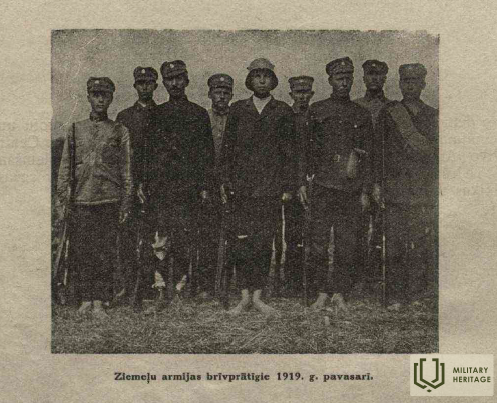
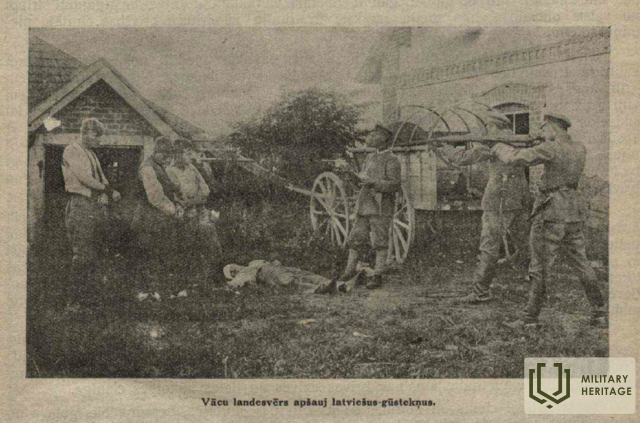
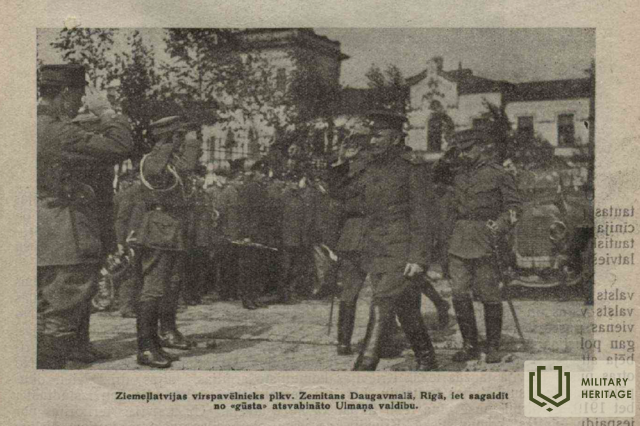


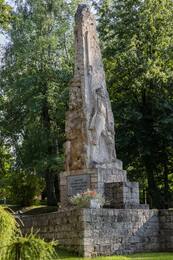
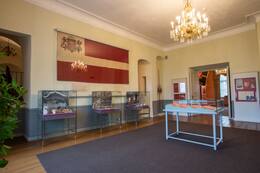
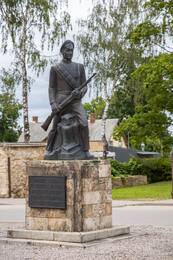
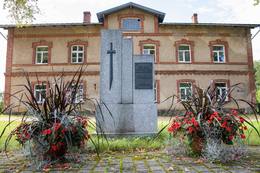
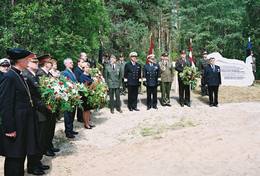
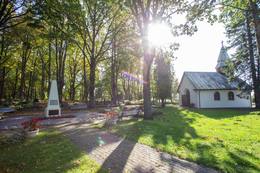
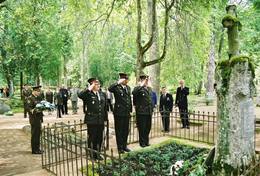
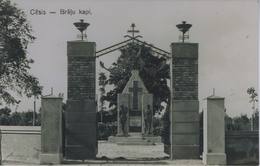
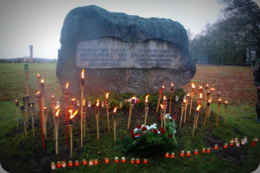
![Limbaži. Valsts prezidents J. Čakste atklāj pieminekli Limbažos I Pasaules karā kritušajiem. Latvijas Brīvības cīņu pieminekļa atklāšana [1923]. Avots: Latvijas Nacionālās bibliotēkas digitālais krājums "Zudusī Latvija".](/g/Poi/00403/44213.png?size=260)

